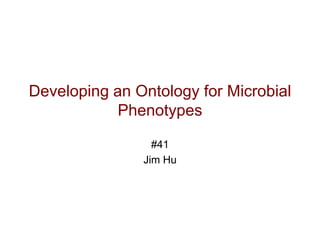Biocurator2012.41.hu
•Descargar como PPTX, PDF•
0 recomendaciones•484 vistas
Jim Hu's presentation at the Biocurator 2012 conference: Developing an Ontology for Microbial Phenotypes
Denunciar
Compartir
Denunciar
Compartir

Recomendados
Recomendados
Más contenido relacionado
Similar a Biocurator2012.41.hu
Similar a Biocurator2012.41.hu (20)
Synthetic Biology and Data-Driven Synthetic Biology for Personalized Medicine...

Synthetic Biology and Data-Driven Synthetic Biology for Personalized Medicine...
Ontologies for life sciences: examples from the gene ontology

Ontologies for life sciences: examples from the gene ontology
Molecular basis of evolution and softwares used in phylogenetic tree contruction

Molecular basis of evolution and softwares used in phylogenetic tree contruction
The Past, Present and Future of Knowledge in Biology

The Past, Present and Future of Knowledge in Biology
Bio-ontologies in bioinformatics: Growing up challenges

Bio-ontologies in bioinformatics: Growing up challenges
Three's a crowd-source: Observations on Collaborative Genome Annotation

Three's a crowd-source: Observations on Collaborative Genome Annotation
Reasoning over phenotype diversity, character change, and evolutionary descent

Reasoning over phenotype diversity, character change, and evolutionary descent
Último
Mehran University Newsletter is a Quarterly Publication from Public Relations OfficeMehran University Newsletter Vol-X, Issue-I, 2024

Mehran University Newsletter Vol-X, Issue-I, 2024Mehran University of Engineering & Technology, Jamshoro
Último (20)
HMCS Vancouver Pre-Deployment Brief - May 2024 (Web Version).pptx

HMCS Vancouver Pre-Deployment Brief - May 2024 (Web Version).pptx
Micro-Scholarship, What it is, How can it help me.pdf

Micro-Scholarship, What it is, How can it help me.pdf
Python Notes for mca i year students osmania university.docx

Python Notes for mca i year students osmania university.docx
UGC NET Paper 1 Mathematical Reasoning & Aptitude.pdf

UGC NET Paper 1 Mathematical Reasoning & Aptitude.pdf
ICT role in 21st century education and it's challenges.

ICT role in 21st century education and it's challenges.
Food safety_Challenges food safety laboratories_.pdf

Food safety_Challenges food safety laboratories_.pdf
Kodo Millet PPT made by Ghanshyam bairwa college of Agriculture kumher bhara...

Kodo Millet PPT made by Ghanshyam bairwa college of Agriculture kumher bhara...
HMCS Max Bernays Pre-Deployment Brief (May 2024).pptx

HMCS Max Bernays Pre-Deployment Brief (May 2024).pptx
Salient Features of India constitution especially power and functions

Salient Features of India constitution especially power and functions
Sensory_Experience_and_Emotional_Resonance_in_Gabriel_Okaras_The_Piano_and_Th...

Sensory_Experience_and_Emotional_Resonance_in_Gabriel_Okaras_The_Piano_and_Th...
Biocurator2012.41.hu
- 1. Developing an Ontology for Microbial Phenotypes #41 Jim Hu
- 2. "Before the physical basis of genes was understood, associating phenotypes with a heritable unit laid the foundation of modern genetics" - Nichols et al 2011
- 3. Goals • Build a classification system (ontology) for microbial phenotypes • Build an annotation system and annotate microbial phenotypes – Given a phenotype, identify kinds of genes and functions likely to be involved – Given a gene, identify phenotypes that may aid understanding of function – Correlate phenotypes to each other – Connect genotypes and phenotypes • Not there yet!
- 4. What’s a phenotype? • Observable characteristics • Individual • Genotype • Environment http://www.flickr.com/photos/max_westby/54275159/
- 5. Building OMP (Ontology of Microbial Phenotypes) Expertise Literature Annotation Examples Ontology system Draft annotations
- 6. Building OMP (Ontology of Microbial Phenotypes) Expertise Literature Annotation Examples Ontology system Draft annotations
- 7. Entities and Qualities • Existing phenotype ontologies are based on the PATO entity-quality system – Entity: a trait, object, process – Quality: a property of an entity – Example from mouse phenotype ontology:
- 8. Entities and Qualities • Making this work for microbes – In some cases the entities are analogous to anatomy terms for microbial cells
- 9. Entities and Qualities • Making this work for microbes – Other cases are population behaviors Budrene and Berg (1991) Nature 349:630 Courtesy of Bonnie Bassler
- 10. State vs Relative Phenotypes • Characteristics of a species/type strain • Changes relative to a reference strain – Not necessarily relative to wild-type
- 11. What do we mean by observable? • Observations vs. inferences – Lac- • Where do we draw the line? – Loss of enzyme activity in an extract: yes – Altered folding of a purified protein: no – Expression patterns of specific genes: yes? – Specific transcriptome patterns: no
- 12. Building OMP (Ontology of Microbial Phenotypes) Expertise Literature Annotation Examples Ontology system Draft annotations
- 13. What is the object of annotation? • Individuals/populations? • Genes? • Genotypes? – “relevant genotypes”? – Genotype differences?
- 14. Things the annotation system needs to express • Properties of wt type strains: – 1. E. coli wt has_phenotype lactose utilization • Mutant phenotypes – 2. E. coli cya has_phenotype decreased lactose utilization • relative_to 1 • Environmental dependence – 3. E. coli cya has_phenotype increased lactose utilization in Environment: + cAMP • relative_to 2 • Genetic interaction – 3. E. coli cya, crp* has_phenotype increased lactose utilization • relative_to 2
- 15. Components needed • Unique annotation ID • Accessions for genotypes for all species/strains – Genes and alleles in a pangenome context • OMP • Relationships for relative phenotypes • Environments • ECO for evidence • Reference
- 16. Future • Build the needed components – OMP in progress – ECO in progress – Universal genotype database?! – Environment ontology? • Build infrastructure – OMP wiki: http://microbialphenotypes.org – Sourceforge SVN for OMP • Coordination with other phenotype projects • Example annotation set for E. coli
- 17. Acknowledgements etc. • TAMU – Debby Siegele – Adrienne Zweifel • NIH R01 GM089636 – Jon Herrera – Will Meza • http://microbialphenotypes.org – Whitley Lanier • micropheno • IGS/Maryland – Michelle Gwinn Giglio – Marcus Chibucos • Virginia Commonwealth – Peter Uetz – Kelly O'Briant – Matt Feltz – Robel Hailu Wolde